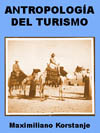Maximiliano Korstanje
Esta página muestra parte del texto pero sin formato.
Puede bajarse el libro completo en PDF comprimido ZIP
(70 páginas, 244 kb) pulsando aquí
REFERENCIAS BIBLIOGRAFICAS
• Achembaum, A.
1972. “Advertising does not manipulate customers”. Journal of Adversiting Research. Abril: 1-13.
• Belk, R.
1974. “An Exploratory Assessment of Situational Effects in Buyer Behaviour”. Journal of Marketing Research. Pp. 156-163.
• Breakwell, G.M
1978. “Some Effects of Marginal Social Identity”. En Tajfel, H. Diferentation between Social Groups. Londres: Academic Press. - 1986. Coping with Theatened Identities. Londres: Methuen.
• Brown, R
1998. Prejuicio: su psicología Social. Madrid: Alianza Editorial.
• Castaño J.M, Moreno A, y Crego A.
2006. “Factores psicosoaciales y formación de imágenes en el turismo urbano: un estudio de caso sobre Madrid”. Revista Pasos: revista de turismo y patrimonio cultural. Vol, 4, (3):287-299.
• Casullo, M.M.
2004. “El Nombre del Hijo: paternidad, maternidad y competencias simbólicas”. Revista Psicodebate, (5).
• Chattopadhyay, A. y Basu, K.
1990. “Humor in advertising: the moderating Role of Prior Brand Evaluation”. Journal of Marketing Research. Pp. 466-476
• Cialdini, R.
1976. “Basking in Reflected glory: three football field studies”. Journal of personality and Social Psychology, 34:366-375
• Clark, T.
1990. “Internacional Marketing and Nacional Carácter: a review and proposal for an integrative theory”. Journal of Marketing. PP. 66-79
• Costa, J.
2003. “Sí Logo, por Joan Costa”. Septiembre 2003. Disponible en www.adlatina.com
• De Devoto Machinandiarena L.
La Influencia del Justicialismo en Chile, 1946-1952. Tesis de Doctorado, Departamento de Historia, UBA 1995.
• Dubois, B y Rovira Celma, A.
1998. Comportamiento Del Consumidor: comprendiendo al consumidor. Madrid: Prentice Hall Iberia.
• Eagleton, T.
2001. La Idea de Cultura: una Mirada política sobre los conflictos culturales. Barcelona: Paidos.
• Evans, M.
2003. “The Sacred: differentiating, Clarifying and Extending Concepts”. Review of Religious Research. Volume 45. (1): 32-47. Brigham: Young University.
• Gardner, M. P.
1985. “The Consumer`s Mood: an important situational variable”. Journal of Consumer Research. (3):281-300.
• Geertz, C
2005. La Interpretación de las Culturas. Buenos Aires: Gedisa Editorial.
• Gensch D. y Ghose S.
1992. “Elimination by Dimention”. Journal of Marketing Research. Pp.417-429.
• Giles, H y otros.
1977. Language, Ethnicity and Intergroup Relations. Londres: Academic Press.
• Gorn, G.
1982. “The Effects of Music in advertising on Choice Behavior”. Journal of Marketing.
• Green, A.
2002. Idees directrices por une psychanalyse contemporaine. Paris : Presses Universitaires de France.
• Janis, I.L y Feshbach, M.
1953. “Effects of Fear Arousing Communications”. Journal of Abnormal and Social Psychology. Pp. 78-92
• Kassarjian, H.H
1971. “Social Character and Diferencial Preference for Communications” Journal of Marketing Research. Pp. 409-418.
• Inkeles, A y otros.
1958. “Modal Personality and adjustment to the soviet socio-political system” Human Relations. (2):3-22
• Lancaster, K
1971. Consumer Demand: a new approach. Columbia: Columbia University Press.
• Muñoz de Escalona, F.
2004. “el Paradigma Austriaco y el estudio del turismo”. Contribuciones a la Economía. Diciembre 2004. Disponible en www.eumed.net/ce
• Polakovic, E.
1978. La formación del Ser Nacional (La Etnogenésis). Buenos Aires: Lumen ediciones.
• Ries A. y Troot J.
1989. Posicionamiento. 1989. Madrid: Editorial Mc Graw-Hill.
• Rosenberg, M y Fishbein, M.
1963. “An Investigation of Relationships between beliefs about an object and the attitude toward that object”. Human Relations :233-240.
• Snyder, C.
1986. “Distancing after group success and failure : basking in reflected glory and cutting off reflected failure”. Journal of Personality and social Psychology, 51:382-388.
• Tajfel, H y Turner, J
1986. “The social identity theory of intergroup behavior” Psychology of Intergroup behavior. Pp.7-24. en Worchel y Austin (eds) Chicago: Nelson.
• Troncoso, C y Lois, C.
2004. “Políticas turísticas y Peronismo: Los atractivos turísticos promocionados en visión de Argentina (1950). Pasos: revista de turismo y patrimonio cultural. Vol 2. (2):281-294.
• Unger, L.S y Stearns, J.M
1983. “The use of Fear and Guilt Messages in Television Advertising: Issues and evidence. Ama Educators Proceedings. Pp. 16-20
• Veblen, T
1974. Teoría de la Clase Ociosa. México: Fondo de Cultura Económica.
• Weber, Max.
1972. Ensayos de Sociología Contemporánea. Tomo I. Buenos Aires: Planeta Agostini.
• Werner K y Weiss H.
2003. El Libro Negro de las Marcas. Buenos Aires: Sudamericana.
• Wilenski, A.
2003. La Promesa de la Marca. Buenos Aires: Temas.
• Weilbracher, W.
1999. El Marketing de La Marca. Barcelona: Editorial Granica.
• Zander, A.
1960. “Unity of Group, identification with group, and self-esteem of members”. Journal of Personality, 28:463-478.


